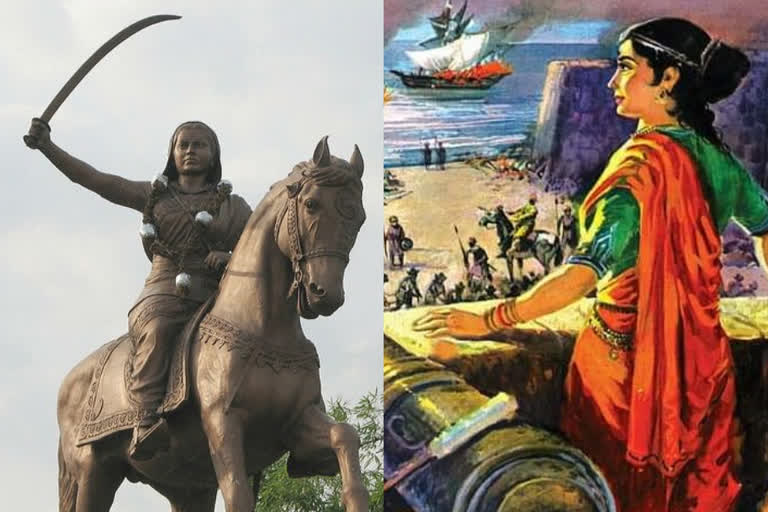Hyderabad: Not just men, the valiant women of this country rallied against the colonial powers putting up stiff resistance. They inflicted great injuries to the political aspirations of the European powers on Indian soil. As we celebrate 75 years of Independence, let us recall two valiant queens who fought the colonial rulers till their last breath.
In Northern Karnataka, Kittur Rani Chennamma is a name that inspires many. On October 23 every year, the people of Belagavi and surrounding regions celebrate Chennamma's first victory against the British. The political agent of British East India company and Dharwad collector John Thackeray underestimated Chennamma and tried to seize her Kittur fort's treasury. He was killed by Rani's lieutenant Amatur Balappa. With her generals Sangolli Rayanna and Balappa, Rani decimated the company's army.
Kittur Rani Chennamma was born in Kakati in Belagavi district in 1778. By 15 when she was married to Raja Mallasarja of Kittur, Chennamma was well versed in archery, horse riding and sword fighting. Raja Mallasarja died in the year 1816 and Mallasarja's son with the first queen Rudramma ascended to the throne. But he died in 1824 and without an heir to the kingdom, Chennamma was left to handle Kittur with the British East India Company on a hot pursuit to devour her kingdom.
Though formally instituted between 1848 - 58, the British East India Company applied the Doctrine of Lapse on Kittur when Chennamma adopted Shivalingappa as her heir in 1824. The political agent John Thackery did not approve her heir and forced her to concede the territory to the company. She tried to plead her cause with the Bombay Presidency and when her request was turned down, she revolted against the British.
Though she succeeded in the first attack, Chennamma was captured in the second attack even as the queen and her men fought valiantly. Sub-collector Munro, the nephew of Thomas Munro - the Governor-General of Madras - was killed by Kittur forces. Chennamma was imprisoned at Bailhongal fort where she died in 1829. Rani's general Sangolli Rayanna attempted to fight back the British with his guerilla tactics but was captured and hanged in the same year when Rani died.
Kittur Chennamma's legacy is alive to date with the Karnataka government celebrating her victory between Oct. 22 and 24 every year.
If Chennamma terrorised the British, three hundred years earlier, a woman from Coastal Karnataka turned out to be a nightmare for the Portuguese - the first colonial powers to land in India. As long as she lived, the Portuguese feared her with their lives. She was Abbakka Mahadevi who ruled a small kingdom of Ullal near Mangalore in Tulunadu. Abbakka belonged to Chowtas who followed matrilineal inheritance and Abbakka was crowned as queen of Ullal in 1525.
After capturing Goa, the Portuguese turned their attention along the Western Coast and captured Mangalore in 1525. The Ullal port next to Mangalore was very prosperous with spice trade with the Arabian peninsula.
A small kingdom ruled by a woman appeared like a cakewalk for the colonial forces but the Portuguese were wrong. She was a smart woman who quickly forged alliances with all local rulers across caste and religion. Her army consisted of soldiers from all communities and the naval force consisted of local Mogaveera fishermen and Muslim Bearys who were good at naval warfare. She was also said to have used agnivana (fire-arrows) on the Portuguese fleet causing large scale damage to the sailing vessels of the invaders.
She forged an alliance with Zamorin of Calicut and kept the Portuguese at bay for the years to come. She refused to pay any tribute to the Portuguese in spite of their repeated demands. Frustrated with her tactics, the Portuguese sent a naval force led by Admiral Dom Alvaro da Silveira in 1555 but she managed to hold her fort. Portuguese invaded Mangalore once again in 1557 but Abbakka's Ullal remained out of their reach for another decade.
Another attack ensued in 1568 when Portuguese general Joao Peixoto with a larger force marched on Ullal. They managed to capture Ullal but Rani escaped. She took refuge in a mosque nearby and quickly gathered her forces. She returned the same night and killed Portuguese general Peixoto. Seventy Portuguese soldiers were captured alive. She also killed their admiral Mascarenhas and chased the Portuguese out of Mangalore.
In the following years, the Portuguese managed to gain territories but Abbakka remained their biggest headache. Unable to match her in battle, the Portuguese found an ally with her estranged husband and defeated her treacherously in 1570. She was imprisoned but she revolted in prison and died fighting.
For Coastal Karnataka, Abbakka is a legend and her valour is passed on generation after generation through Yakshagana, the popular folk art of coastal Karnataka. She is also sung in Daiva Kola, a local ritual dance of trance. Honouring her, the Indian Coast Guard named first of their Inshore Patrol Vessels manufactured from Hindustan Shipyard as Rani Abbakka and the Rani Abbakka class consists of five patrol vessels keeping a vigil along the coasts of the independent country.
Read: 75 Years of Freedom: Why Bal Gangadhar Tilak is called 'Father of Indian Unrest'



